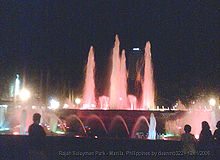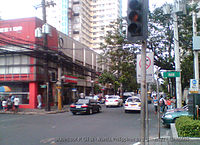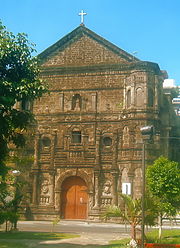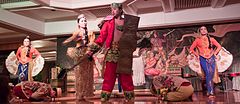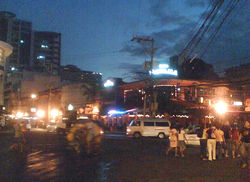- Malate, Manila
-
For the malic acid anion, see malate.
Manila 5th congressional district which includes Malate Location of Malate in Manila's 5th legislative district Country Philippines Region National Capital Region City Manila Congressional districts Part of the 5th district of Manila Barangays 57 Population (2007[1]) - Total 78,132 Malate is an old district of the city of Manila in Metro Manila, the Philippines. The district is located at the southern end of the city of Manila, bordered by Pasay City to the south, by Manila Bay to the west, by the district of Ermita to the north and by the districts of Paco and San Andres to the east.
Contents
Origin of the name
The word Malate is believed to have stemmed from the corruption of the Tagalog word "maalat," meaning "salty." Legends have it that tidewaters from Manila Bay flowed in-land as far as where the Remedios Circle is presently located. The salty sea water polluted the fresh water collected from wells, thus making drinking water in the area as salty as seawater.
History
Malate during the Spanish colonial period was an open space with a small fishing village. During the Spanish period, the center of activity was focused around the Malate church, the Our Lady of Remedios Parish that had a cult following among pregnant women having a difficult pregnancy.
When the Americans came to the country by the turn of the 19th century, American urban planners envisioned the development of Malate as the newest and trendiest exclusive residential area for American families. American expatriates and some of the old Spanish mestizo families populated the district in modern high rise apartments and wide aread bungalows.
After World War II, the extensive damage and carnage left behind by retreating Japanese occupational forces in the area and by the mortar shelling done by liberating by joint Filipino and American forces was not enough to level all the buildings and houses. Displaced wealthy families who abandoned their posh Malate homes returned and re-built their private villas and kept the whole district exclusively residential until the 1970s.
There are two sides of Malate, the domain of wealthy expatriates west of Taft Avenue from Pedro Gil street to Quirino Avenue and the lower middle class families east of Taft Avenue.
The once exclusive residential areas on the western portion of Malate started to transform in the 1970s into a commercial area with some big lotted houses and residential apartments being converted into small hotels and pensionne houses. Specialty restaurants and cafes also started to open in the district, as a result of the spill over of business from next-door Ermita district, which was for a time the red-light district of Manila.
Malate has been called the center of gay night life,[2] and has a Gay Pride Parade every year.[3]
The western side of Malate across Taft Avenue remains as the quiet middle class homes with several apartment rows converted into dormitories for students enrolled at nearby schools.
Accessibility
The district can be directly accessed by main roads like the Roxas Boulevard, Quirino Avenue and Taft Avenue with well-known streets like Mabini and M.H. del Pilar.
The Light Rail Transit (LRT-1) rolls along Taft Avenue and stops at three stations located in Malate, the Vito Cruz Station, Quirino Station, and the Pedro Gil.
Facilities
In the 1990s, Malate and its neighbor Ermita has been "cleaned-up" and legitimate big businesses have sprouted in the district with hotels like the Hyatt Hotel and Casino, the Pan Pacific Hotel, the Manila Diamond Hotel, Sheraton Hotel, Grand Boulevard Hotel and the Cherry Blossoms Hotel.
Shopping can be done at the Manila's first enclosed and fully air-conditioned shopping mall, Harrison Plaza that houses an SM Department store and Shopwise, a hypermarket owned by Rustan's. It once housed high-end retailer Rustan's (closed early 2000s).
Malate, east of Taft Avenue is continuously transforming itself as the center of recreation and entertainment for Manila with more restaurants, boutiques, entertainment halls, bars, discos and novelty stores opening for business. Life in the area that usually starts as soon as the famous Manila Bay sunset is over and the neon lights and loud glaring sounds are turned-on.
The block bounded by the streets; Maria Orosa, Julio Nakpil, Adriatico and Remedios have become synonymous to "street parties," al fresco drinking and dining, street dancing and even ground-level concerts.
Government offices
The country's forefront financial agencies like the Department of Finance, the Bangko Sentral ng Pilipinas or BSP (Philippines Central Bank) and lending institution LandBank of the Philippines established their headquarters in the district, while the National Naval Command Headquarters of the Philippine Navy, a unit of the Armed Forces of the Philippines is at the boundary limits of Manila and Pasay City along Roxas Boulevard.
Locating a fully functional medical facility is the city-subsidized Ospital ng Maynila Medical Center, located at the corner of Roxas Blvd. and Quirino Ave.
Schools
Malate is home to several educational institutions such as St. Scholastica's College, De La Salle – College of Saint Benilde, De La Salle University, the Philippine Christian University, the Philippine Women's University, St. Paul's College, and for secondary-level education is the Jesus Reigns Christian Academy and Malate Catholic School.
The only public school managed and operated by the city government of Manila in the district is the Doña Aurora Quezon Elementary School.
Recreation
The district is also home to the country's first sports stadium, the Rizal Memorial Sports Complex and the country's premiere zoological park, the Manila Zoological and Botanical Garden.Promenades by the Manila Bay has been made more convenient and safe with the opening of the Manila Baywalk that starts near the junction of Pedro Gil St. and Roxas Boulevard. Tourists and alike can enjoy different types of al fresco restaurants and cafes and further down south of the path is the exclusive Manila Yacht Club.
In front of the Malate Church or the historical Parish of Our Lady of Remedios is the Rajah Sulayman Park that boasts of a dancing water fountain. Further down Remedios street towards the east is the Remedios Circle that was improved and renovated under the administration of Mayor Jose L. Atienza, Jr. in 2006.
Several restaurants have been erected at Baywalk in Roxas Boulevard. However, because of a city ordinance, the businesses are now located in the bayside of SM Mall of Asia. An open playground across the Manila Zoological and Botanical Garden was also renovated and improved and is now called, the Leveriza Children's Park.
Restaurants and Nightlife
Night clubs, bars and discothèques are along the Malate portion of M.H. del PIlar, Mabini and Adriatico streets. Upscale restaurants line up from the corner of Adriatico and Remedios streets with the opening of landmark restaurants like the Cafe Adriatico, Larry's Bar and the Korean Village.
Visual and performing artists found a haven in Malate and in the 1980s, the open and nonexclusive watering hole for artists was Penguin Bar along Remedios Street fronting the Remedios Circle. Further along Remedios street is the M Chereville Hotel, for those who want the quiet and seclusion, nestled in the pulsating heart of Manila.
For a period of time, Malate was the place where artists, poets, writers, actors, and film industry professionals gathered, where there was no degree of hypocrisy practiced, just the basic rule of "come and be yourself, express yourself."
Despite the reign of a dictatorial regime in the 1970s into the 1980s, the glitzy life in Malate flourished and more into the later part of the 1980s.
Notable residents
- Herminio A. Astorga
Notes
- "By Sword and Fire: The Destruction of Manila in World War II, 3 February-3 March 1945" by Alphonso J. Aluit (1994) Bookmark, Inc. © 1994 National Commission for Culture and the Arts ISBN 971-569-162-5
References
- ^ Final Results - 2007 Census of Population
- ^ Considine, Austin (June 4, 2006), "Hip-Hopping the Night Away in Manila", The New York Times, http://travel2.nytimes.com/2006/06/04/travel/04surfacing.html?ex=1307073600&en=498bb5e8105a3c75&ei=5088, retrieved 2007-12-20
- ^ Naylor, Christopher, "The Philippines - A Mix of City Life and Island Relaxation", PlanetOut.com, http://www.planetout.com/travel/article.html?sernum=6764, retrieved 2007-12-20
City of Manila Culture · Crime · Demographics · Economy · Geography · Government · History · Mayor · Notable Residents · Transportation 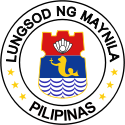
Legistlative districts of Manila Districts of Manila Binondo · Ermita · Intramuros · Malate · Paco · Pandacan · Port of Manila · Quiapo · Sampaloc · San Andres · San Miguel · San Nicolas · Santa Ana · Santa Cruz · Santa Mesa · Tondo
Mayors of Manila Justo Lukban · Ramon Fernandez (politician) · Miguel Romualdez · Tomas Earnshaw · Valeriano Fugoso · Jorge B. Vargas · León G. Guinto, Sr. · Juan L. Nolasco · Manuel de la Fuente · Arsenio Lacson · Antonio Villegas · Ramon Bagatsing · Mel Lopez · Alfredo Lim · Lito Atienza · Alfredo Lim
Categories:- Districts of Manila, Philippines
- Gay villages
Wikimedia Foundation. 2010.


